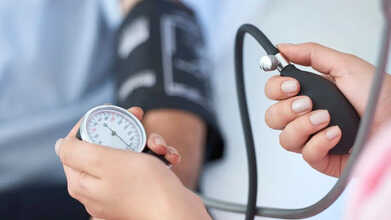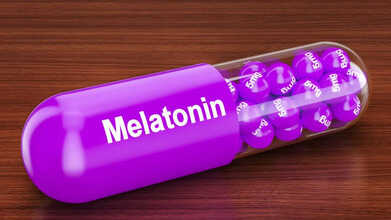- Health Conditions A-Z
- Health & Wellness
- Nutrition
- Fitness
- Health News
- Ayurveda
- Videos
- Medicine A-Z
- Parenting
You Scroll 4 Mt Everest In An Year—But That's Only Causing Brain Rot

Credit: Canva
A recent study found that we scroll a distance which is equivalent to four times the height of Mount Everest in a year. Intrestingly, it stated that an average person's newsfeed in terms of scroll length can be the same as the Statue of Liberty in a day, two Eiffel Towers in a week and three Burj Khalifas in a month. But where is all this doom-scrolling taking us?
If neurologists and brain scientists are to be believed, then all these hours we spend mindlessly with our phones have only resulted in brain rot. If you ever want to witness the last vestiges of human intellect swirling down the drain, you just open your phone and type the words "skibidi toilet". The video, which will emerge, features an animated human head protruding from a toilet bowl while singing the nonsensical lyrics "skibidi dop dop dop yes yes". The 11-second clip has been viewed more than 215 million times, directly highlighting the intensity of brain rot.
Not so surprisingly, Brain Rot is the Oxford word of the year 2024. The dictionary defines it as "the supposed deterioration of a person's mental or intellectual state, especially viewed as the result of overconsumption of material (now particularly online content) considered to be trivial or unchallenging".
Technology Is Causing Brain Rot And We Know It
Beyond the obvious, there are still several people who are aware of how literally technology is rotting our brains, and how decisively compulsive internet use is destroying our grey matter. For the uninitiated, grey matter is the region with high concentration of neurons in the brain and spinal cord.
The concept was portended almost 20 years ago when scientists studied the effects of the then-new invention called "email". They wanted to fathom the impact of a barrage of information on the brain. After conducting multiple studies, they concluded that constant cognitive overload had a more negative effect than taking cannabis, with IQS of participants in a study dropping an average of 10 points. And imagine this was before the internet brought the world to our fingertips.
How To Stop Doomscrolling?
This is not about completely avoiding screens (because let’s be real, that's practically impossible). But we can help kids and teens reduce their reliance on technology and recalibrate their brains. Here are a few tips:- Lead by example: The most effective way to change behaviour is to model it. Parents who set their own boundaries around screen time and engage in offline activities will set a positive example for their children.
- Set digital boundaries: Start by setting limits on screen time, whether it's through built-in screen-time trackers or apps that help monitor usage. Encourage regular breaks and give time for the mind to relax and recharge.
- Tech-free hours: One of the best ways to reset is by establishing tech-free zones, like at mealtimes or right before bed. These are opportunities to engage in meaningful, face-to-face conversations. As tempting as it may be to scroll late at night, it’s important to keep phones out of reach during sleeping hours—screens can disrupt sleep patterns and negatively impact health.
- The 80/20 rule: Aim for 80% of screen time to be dedicated to educational, enriching or creative content. The other 20% can be reserved for lighter, more entertaining content.
- Rediscover hobbies and offline activities: Encourage kids to get involved in hobbies and activities that don’t involve screens. Whether it’s taking a walk in nature, playing a sport, crafting, reading a book or learning a musical instrument, these offline experiences help foster curiosity and creativity—qualities that doomscrolling tends to suppress.
NHS Doctors Issue Warning For Anyone Using Ibuprofen, Naproxen or Aspirin; Here's Why

Credits: Canva
Anyone who relies on ibuprofen, naproxen or ordinary-strength aspirin for pain or arthritis has been advised to be cautious, after an NHS doctor raised concerns about the risks of long-term use. Dr Mark Porter, a GP known for his appearances on The One Show, said many people do not realise these medicines can lead to stomach ulcers and internal bleeding.
He noted that bleeding in the stomach or upper gut is a serious medical emergency. An audit led by researchers at the University of Oxford shows that this type of bleeding leads to at least 60,000 hospital admissions each year, and about one in ten patients does not survive to return home.
NHS Doctors Issue Warning for Anyone Using Ibuprofen, Naproxen or Aspirin
Dr Porter referenced a report published in the journal Gut, which compared outcomes from 2007 and 2022. The data revealed how many people who suffered gut bleeds were taking medicines, both prescribed and over the counter, that could trigger or worsen the problem.
As per Times,, he said that nearly half of the 5,141 patients analysed in the audit had been taking some type of drug that increases the chance of bleeding. These included low-dose aspirin, clopidogrel and anticoagulants such as warfarin and apixaban. In addition, one in fourteen patients had been using a non-steroidal anti-inflammatory drug (NSAID) like ibuprofen, naproxen or normal-dose aspirin, which are commonly used to relieve pain and treat arthritis.
Why NSAIDs Can Be More Dangerous Than People Realise
Dr Porter said many people who take low-dose aspirin or blood thinners to lower the risk of stroke, heart attack or blood clots know that these medicines carry a bleeding risk. The concern is that far fewer people understand that NSAIDs can be just as harmful for some individuals. According to him, NSAIDs are responsible for about a third of all NHS hospital admissions linked to adverse drug reactions. These admissions take up roughly one in five hospital beds. Beyond gut bleeding, NSAIDs can also raise the chance of heart attacks, strokes and kidney problems.
Stomach Symptoms Can Worsen With Long-Term Use
People who already struggle with heartburn or indigestion often notice that occasional ibuprofen or aspirin makes their symptoms worse. Dr Porter explained that, when taken frequently or over long periods, these medicines can do much more damage. Their effect on prostaglandins, which helps ease pain, also weakens the stomach’s natural defences against its own acids. This can lead to irritation, ulcers, bleeding and in some cases, a perforation.
He added that although the overall risk for most people is small, doctors have become more aware of these dangers. As a result, NSAID use has fallen in many countries over the past 25 years. Even so, these drugs are still widely prescribed, especially for older adults. Some estimates suggest that nearly one in five people over 65 has taken at least one course in the past year.
Why Protective Medicines Do Not Remove All Risks
Doctors often prescribe antacid medicines such as omeprazole alongside stronger NSAIDs like naproxen to help protect the stomach. Dr Porter clarified that these medicines lower the risk of bleeding, but they do not remove it fully. He said certain groups should be particularly careful.
These include people on low-dose aspirin or similar drugs like clopidogrel, anyone taking anticoagulants such as warfarin or apixaban, those who often have indigestion or heartburn, anyone with a history of stomach or duodenal ulcers, people living with heart failure or chronic kidney disease, and adults over 65 who are not taking stomach-protective medication.
Aspirin Should Not Be Taken Casually
Dr Porter added that one painkiller should never be taken without a doctor’s instruction. He said he would avoid using aspirin for day-to-day discomfort unless advised by a medical professional. For issues such as a hangover, a headache or a sore knee, paracetamol is usually safer than ibuprofen, although it may not offer the same level of relief. An occasional NSAID is unlikely to cause harm for most people, as long as they are not in a high-risk group. However, anyone who needs pain relief often, whether daily or several times a week, should speak to their GP to decide on a safer plan.
Dr Porter offered one final piece of advice. While vomiting blood is an obvious emergency, an earlier sign of slow bleeding in the upper gut can be easy to miss. Black, tar-like stools, known as melena, should never be ignored. Anyone who notices this should seek medical help without delay.
What Time Is Blood Pressure Usually Highest? Here Is What Cardiologists See Most Often

Credits: Canva
Blood pressure shifts throughout the day in a steady rhythm shaped by hormones, activity, and the body’s internal clock. Doctors call this the circadian pattern of blood pressure. It helps the body prepare for wakefulness, support daytime tasks, and recover during sleep.
While this rise and fall is normal, the timing of these changes matters, especially for people with hypertension or heart conditions. Dr Sunil Rana, Associate Director and Head of Internal Medicine (Unit III), Asian Hospital, explains how these variations unfold across a typical day.
Why Blood Pressure Peaks in the Early Morning
In a normal cycle, the highest readings appear between six in the morning and nine in the morning. This is the point when the body shifts from sleep to wakefulness. Hormones such as cortisol and adrenaline surge during these hours. They raise the heart rate and tighten blood vessels to help the body feel alert.
Dr Sunil Rana said, “This rise is natural, yet it carries added importance for people with hypertension, diabetes, sleep disorders, or heart disease. During these early hours, the risk of heart attack, stroke, and other vascular complications is known to be higher because the body is under greater strain.”
How Daytime Habits Shape Midday and Afternoon Readings
After the morning peak, blood pressure usually settles into a moderate range through the late morning and early afternoon. Daily tasks like walking, working, travel, and problem-solving maintain a steady level. At the same time, several routine triggers can push these numbers higher. Mental stress, dehydration, caffeine, skipped meals, and long periods of sitting often raise readings through the day.
Dr Sunil Rana, told us that people who face chronic stress, irregular work hours, or disrupted eating patterns tend to see wider swings. Toward late afternoon, blood pressure usually dips slightly as the body begins to wind down. However, heavy meals, alcohol, emotional tension, or intense workouts in the evening can cause short-lived spikes.
Why Blood Pressure Falls at Night?
During sleep, the body enters a quieter phase known as nocturnal dipping, where blood pressure typically drops by ten to twenty percent. This drop gives the heart and blood vessels a chance to rest. The dip is an important part of cardiovascular recovery.
Dr Sunil Rana said, “Not everyone experiences this nightly reduction. People with kidney disease, diabetes, sleep apnea, or autonomic dysfunction may show little or no dip at night, which is linked to a greater risk of long-term heart problems. Irregular sleep routines, late-night screen use, and chronic insomnia can also disrupt this natural decline and keep nighttime readings higher than expected.”
Factors That Influence These Daily Changes
The steepness of these fluctuations differs from person to person. Age, lifestyle, food habits, alcohol, smoking, weight, and stress all play a part. Night-shift workers may show the reverse pattern, with pressure rising at night instead of morning. Medication timing also shapes the curve, especially in people who take antihypertensive drugs.
Doctors often advise checking blood pressure at different times of the day, including early morning and before bedtime, to understand a person’s individual rhythm more clearly.
Understanding that blood pressure is naturally highest in the early morning helps in planning treatment and daily routines. It guides medication timing, supports healthier morning habits, and strengthens long-term control. It also helps people at higher risk take steps to protect their heart during the hours when it needs the most support.
Melatonin Overuse: Side-Effects, Long-Term Risks, And How To Use It Safely

Credits: Canva
Melatonin has become one of the most widely used sleep aids in recent years. Many people rely on it to manage jet lag, night-shift sleep cycles, or occasional insomnia. Surveys show that a large share of adults have tried melatonin at some point, often assuming it is completely harmless because it is available over the counter.
In most cases, short-term use is safe, but a growing number of emergency calls and medical reports show that misuse and high doses can cause real problems, especially when taken without guidance.
We got in touch with Dr Lohit Kumbar, Endocrinologist at SDM College of Medical Sciences and Hospital in Dharwad, who explained how melatonin overuse affects the body, the long-term concerns linked to prolonged use, and the safest way to take it.
How Melatonin Overdose Affect the Body?
Melatonin is produced naturally by the pineal gland at night. It plays a central role in sleep regulation, but it also influences blood pressure, body temperature, and the body’s antioxidant activity. Dr Kumbar told us, supplements mimic this natural hormone and are often used for insomnia and several neurological or developmental conditions, including Alzheimer’s disease, autism spectrum disorder, and mild cognitive impairment. Because it supports these functions, many assume that more melatonin means better sleep, which is not true.
Dr Kumbar notes that even though melatonin is generally safe, high doses can cause immediate discomfort. The most common signs of excess intake include daytime sleepiness, headache, dizziness, nausea, and sleep disturbances. These symptoms usually appear when the dose goes beyond 10 mg per day, which is far above what most people need. In a few rare situations, more serious reactions have been reported. These include autoimmune hepatitis, confusion, optic neuropathy, psychotic episodes, seizures, and unusual skin eruptions. Such cases are linked to a wide range of doses, from as little as 1 mg to as high as 36 mg, suggesting that individual sensitivity varies.
Melatonin Long-Term Risks You Should Know About
While overdose symptoms appear quickly, long-term risks build up slowly. Prolonged melatonin use, especially over six months or more, may affect reproductive hormones. According to Dr Kumbar, this can lead to reproductive dysfunction, delayed puberty in younger users, and concerns about fetal development if the supplement is taken during pregnancy. These risks are not yet fully understood, largely because long-term data is limited, but the existing evidence is strong enough for doctors to urge caution.
Pregnant and breastfeeding women, in particular, are advised to avoid melatonin unless a doctor specifically recommends it. Children and adolescents should also use it only under strict medical guidance.
How to Use Melatonin Safely
Safe use begins with sticking to the lowest effective dose. Dr Kumbar recommends keeping daily intake at or below 5 to 6 mg. Most adults respond well to even smaller amounts, and higher doses do not improve sleep quality. If melatonin becomes a regular part of your routine, medical supervision is important. A doctor can help determine the right dosage, ensure there are no interactions with other medicines, and monitor any side effects.
Melatonin can be helpful when used responsibly, but it is not a cure-all for sleep problems. Understanding the risks of overuse ensures you protect your long-term health while still getting the rest you need.
© 2024 Bennett, Coleman & Company Limited

